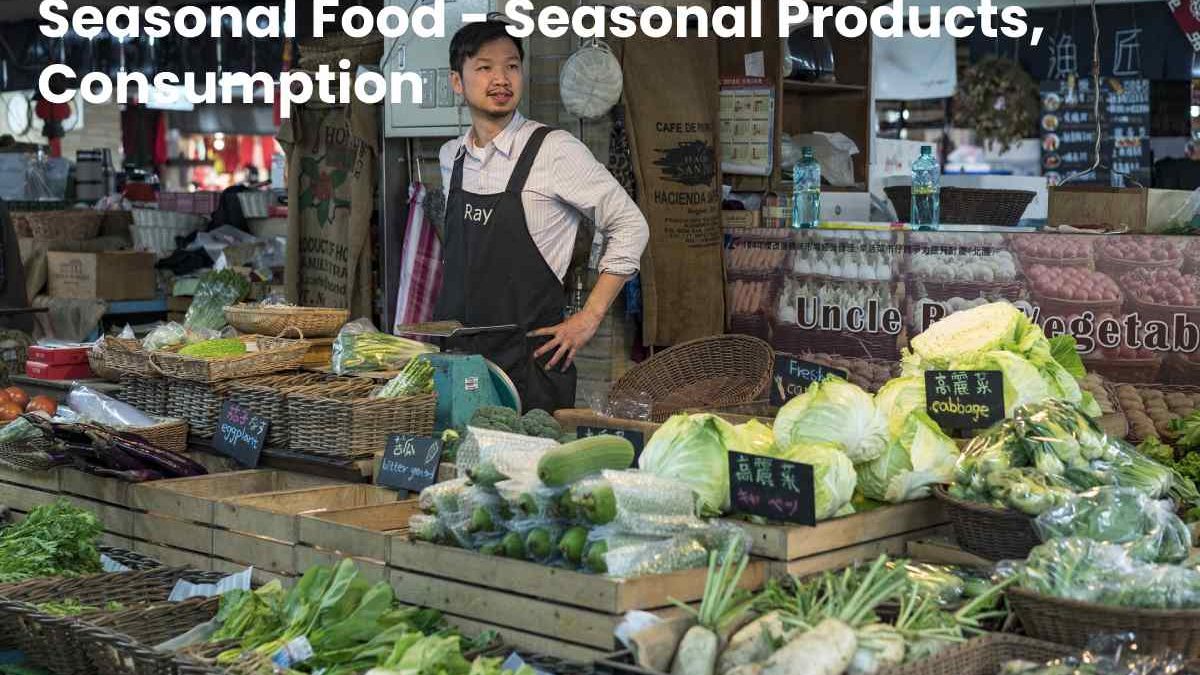Table of Contents
What is Seasonal Food, and Why to Consume these Foods?
Seasonal Food – With globalisation, we have become familiar with consuming vegetable fruits from all over the world at any time. We eat melons in January and artichokes in August, and it seems like the most normal thing in the world, even strange if we don’t find it in the supermarket. Of course, it is very comfortable to insist on making a fresh strawberry cake in October, but we do not consider the consequences of this open food bar.
Season impacts the environment by bringing avocados from Peru and papaya from Costa Rica. Thousands of kilometres travel every day to reach our shopping cart, with the pollution and use of resources. And not only the environmental footprint but also the one they leave on our palate. For fruits and vegetables to arrive in our country in optimal conditions, they are collected long before they mature, finishing their process in cold storage, obviously impacting their flavour, texture, and quality.
Seasonal Food in Spring
We start to spring with some grilled wild asparagus with a spinach scramble: rising green leafy vegetables, medlars, and cherries.
March
We start the asparagus season, rich in magnesium, calcium, phosphorus, and potassium and high in fibre and antioxidants. And in addition, it is also the season of Avocados, lemons, oranges, kiwis, chard, celery, cauliflower, cabbage, endives, spinach, and lettuce—a perfect option to start spring nights, grilled asparagus with a squeeze of lemon.
April
In April, a thousand glasses of water and artichokes! That obscure object of desire, high in fat. B and C, iron, calcium, magnesium, and zinc. How do we cook them? We can make them steamed, grilled, fried, or candied. Make the most of the season for this vegetable, which lasts only until June! This month, you can also enjoy Avocado, orange, chard, endive, asparagus, spinach, celery, peas, and carrots.
May
In May, the avocado season ends, so you have to take advantage of them. Let’s take advantage of the fact that the temperature rises to make a cold avocado and pea soup. Let’s not forget either: Apricot, cherry, strawberry, chard, artichoke, endive, asparagus, peas, broad bean, lettuce, and carrot. Then we can find them, but not in proximity; they will surely be from Peru or Mexico.
Seasonal Food in Summer
The temperature rises and fresh food arrives, an explosion of fruits in summer. Take the opportunity to make many fruit salads, watermelon, melon, nectarines.
June
We start the month with some peppers stuffed with rice with zucchini and a fresh cucumber salad. Apricot, cherry, raspberry, strawberry, watermelon, chard, garlic, endive, bean, lettuce, potato, and carrot are seasonal food. And the courgettes, cucumbers, and peppers arrive—vegetables with high water content, digestive and satiating.
July
The heat rises, and gazpacho is imposing on Spanish tables. And the stars of summer arrive, the tomato and the melon. We know the properties of tomato, rich in Vit A, C, and K, iron, and potassium. A very fresh melon provides phosphorus, calcium, and magnesium for dessert.
August
The pastry shops are filled with fig cakes because we are in the middle of the season. A healthier option could be a homemade fig jam so that they do not spoil; it will provide us with magnesium, manganese, calcium, potassium, Vit C, and K.
In August, we can also eat: Raspberry, peach, melon, blackberry, nectarine, pear, watermelon, tomato, Aubertine, courgetti, onion, bean, lettuce, potato, cucumber, pepper, beet, and carrot.
We start with the most outstanding product of autumn, the pumpkin.
September
September begins, and we already see everything in orange and brown tones. Half of the pumpkins consumed in Spain are grown in the Canary Islands and Andalusia, and there is a smaller production on the Mediterranean coast. We find them made in China, Ukraine, or Mexico out of season. Other foods in season: Raspberry, pomegranate, fig, apple, peach, melon, blackberry, pear, tomato, grape, chard, aubergine, lettuce, onion, endive, spinach, bean, corn, cucumber, pepper, leek, and carrot.
October
You can now put sweet potatoes and broccoli in your shopping cart. We are craving a vegetable cream with these two ingredients that will provide us with fibre, iron, potassium, zinc, Vit A, and C. In addition to sweet potatoes and broccoli, we find Kiwi, chard, pumpkin, onion, cabbage, endive, spinach, lettuce, leek, radish, beet, and carrot.
November
Citrus is back! Lemon, lime, mandarin, orange, Kiwi. Before this time, we will find oranges from Brazil or mandarins from China. Not everything is citrus. There are also: Avocado, tangerine, chard, sweet potato, broccoli, thistle, mushroom, cabbage, cauliflower, endive, spinach, lettuce, turnip, leek, radish, beet, and carrot. We hydrate, we fine-tune our fat levels. Cand, above all, we enjoyed an excellent fresh orange juice.
Seasonal Food in Winter
Know, officially in winter and under the blanket on the sofa. To warm-up, we taste a vegetable soup with leek, carrot, turnip, and spinach. We finish with a curry of chickpeas and thistle cauliflower.
December
Brussels sprouts, the classic winter vegetable. Perfect stewed or sautéed in a pan with a bit of garlic and chopped leek. In December, we also found Avocado, persimmon, Kiwi, lemon, orange, grapefruit, chard, celery, broccoli, thistle, cabbage, cauliflower, endive, spinach, turnip, leek, and carrot.
January
And luckily, after the excesses of Christmas, lettuce season arrives. Light salads to resume the routine. A tip put a salad base on each of your plates and then add the rest of the food on top, so we don’t fill them up so much and eat more vegetables. In January, we find other seasonal products: Avocado, Kiwi, lemon, orange, chard, celery, thistle, cabbage, cauliflower, endive, spinach, and leek.
February
There are no new seasonal foods in February, so let’s take advantage of the cold for a Vichysoisse accompanied by cauliflower couscous with garlic chard. On the other hand, we would also have Avocado, Kiwi, lemon, orange, celery, cabbage, endive, spinach, lettuce, and leek.
Bet on Seasonal Food
We have already commented on it repeatedly: rule out the miracle diet. As has been done for many years with the Mediterranean diet, the smartest thing is to bet on what that nature offers us and bet on foods that are at their best, those available in the year’s season in which we find ourselves. In addition, they are always the most brilliant option in times of crisis, when we usually decide what we buy based on our pocket.
To find out which foods are in season, you can consult the website of the Mediterranean Diet Foundation. In January, this institution offers us a list by category of food that recommends us to bet on:
- Fruits: persimmon, custard apple, strawberry-strawberry, Kiwi, lemon, tangerine, apple, orange, banana, grapefruit.
- Vegetables and vegetables: chard, garlic, artichoke, celery, aubergine, broccoli, zucchini, thistle, onion, red cabbage, cauliflower, endive, escarole, spinach, peas, broad beans, green beans, lettuce, turnip, cucumber, pepper, leek, radish, beet, cabbage, tomato, carrot.
- Fish and seafood: eel, cod, cockles, sea bream, shrimp, carp, Norway lobster, halibut, pink lobster, sea bass, mussels, grouper, oysters, pomfret, perch, octopus, salmon, shark, trout, scallops.
Tips when Buying – Seasonal Food
When you go to the market, do not forget to bring a list to buy the foods you need to prepare your daily meals. Reviewing what you have in your pantry and refrigerator will allow you to buy what you need and thus prevent food from spoiling.
Keep in mind that you should choose the ones with the best colour and do not have dents, stains, or signs of deterioration when you buy fruits and vegetables. Likewise, when selecting the fish, take a good look at the product before choosing it and do not lose sight of the following tips to opt for the best:
Conclusion
However, Seasonal food is healthier, cheaper, and more ecological. They also taste like they should and odour fantastic as if they had been full-grown in a garden in your backyard.
Healthier and tastier: they are full-grown in rich soils, with the right weather and completing their natural calendar. They keep all their nutritional properties, texture, smell, and flavour intact at the harvesting time. Cheaper: during specific periods of the year, the availability of these products in stores is more. And as supply increases, values decrease.
More ecological: We respect the natural cycle and the food production area, avoiding the implementation of intensive monocultures that deplete the soil. And in addition, energy expenditure is reduced by minimizing the need for transport, distribution, and storage.
Also Read: Healthy lifestyle


